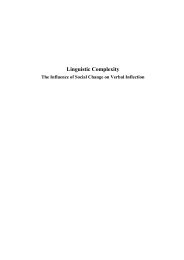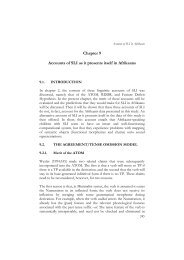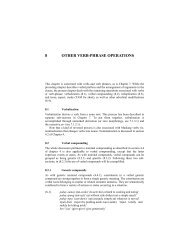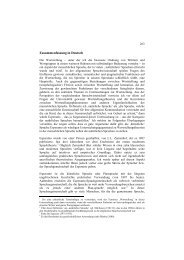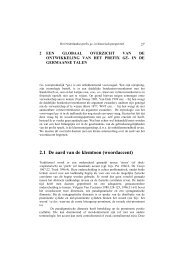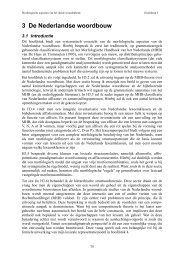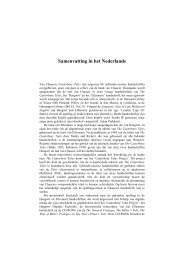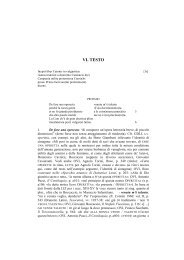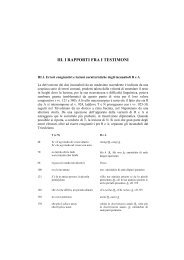chapter 2 stance adverbs qualifying a standpoint - LOT publications
chapter 2 stance adverbs qualifying a standpoint - LOT publications
chapter 2 stance adverbs qualifying a standpoint - LOT publications
You also want an ePaper? Increase the reach of your titles
YUMPU automatically turns print PDFs into web optimized ePapers that Google loves.
54<br />
CHAPTER 2<br />
disjuncts even though they may resemble them, despite the paraphrase with<br />
speaking that both groups can take.<br />
As I argue in the following section, domain <strong>adverbs</strong> 34 can be considered<br />
together with the so-called modal and evidential <strong>adverbs</strong> as belonging to the<br />
same group of <strong>adverbs</strong> that may realise linguistically the epistemic way of<br />
<strong>qualifying</strong> <strong>standpoint</strong>s. This is possible because the semantic criterion of degree<br />
of commitment to the truth/falsity of the proposition is not a decisive criterion<br />
when it comes to the qualification of a <strong>standpoint</strong>.<br />
2.3.1.2 Emphasising the quality of the evidence<br />
In general, it is acknowledged that modal <strong>adverbs</strong> like perhaps and clearly, and<br />
evidential <strong>adverbs</strong> like apparently and allegedly indicate strong or weak degree of<br />
commitment to the truth of the proposition that is asserted in a sentence and<br />
can thereby be used in order to boost or downplay the effect that the asserted<br />
sentence has or the expectations that it creates for the audience (Holmes, 1984;<br />
Sbisà, 2001). In this section, I argue that there is no difference in the discourse<br />
effect that using a modal or an evidential adverb has when <strong>qualifying</strong> a<br />
<strong>standpoint</strong> in an argumentative discourse. I also argue that domain <strong>adverbs</strong><br />
follow the same pattern and that all three groups of <strong>adverbs</strong> can be considered<br />
as the linguistic realisation of the epistemic way of <strong>qualifying</strong> <strong>standpoint</strong>s. This<br />
way of <strong>qualifying</strong> <strong>standpoint</strong>s seeks to emphasise the quality of the evidence<br />
that the protagonist is ready to forward in support of the <strong>standpoint</strong>.<br />
In the pragma-linguistic literature, the equation between the lexical<br />
meaning of such <strong>adverbs</strong> as certainly, clearly, obviously, perhaps, possibly, probably,<br />
surely, and the effect of emphasising or acknowledging a limitation in the<br />
speaker‟s knowledge or commitment is not a straightforward one. Aijmer<br />
(2002b), reviewing some studies concerning <strong>adverbs</strong> such as certainly, no doubt,<br />
and surely, remarks that scholars have different views on whether these <strong>adverbs</strong><br />
mark certainty or uncertainty. Part of the disagreement arises from the<br />
confusion between meaning as lexical meaning of these words and meaning as<br />
the use that can be made of these words in context. The question for my study,<br />
however, concerns the effect of the language user‟s choice to mark a high or<br />
low degree of probability/certainty in argumentative discourse. Whether<br />
marking a high or low degree of probability (or of certainty or commitment)<br />
can be achieved in a particular context by using certainly and in another by using<br />
no doubt or probably is of no direct importance here. Having said that, it should<br />
34 In the list of domain <strong>adverbs</strong> that I present in Table 2, I do not include the <strong>adverbs</strong> essentially,<br />
fundamentally, nominally, and outwardly. This is because they do not function in the same way as<br />
<strong>adverbs</strong> like technically and theoretically, which indicate a field or perspective from which the<br />
language user asserts the truth of the proposition. The <strong>adverbs</strong> basically and generally are also<br />
missing from this list because they are not used in order to specify some field but rather to<br />
indicate the style of speaking. They appear together with <strong>adverbs</strong> like briefly, figuratively, and roughly<br />
under „illocutionary <strong>adverbs</strong>‟ in the third column. See 2.3.3.1.



